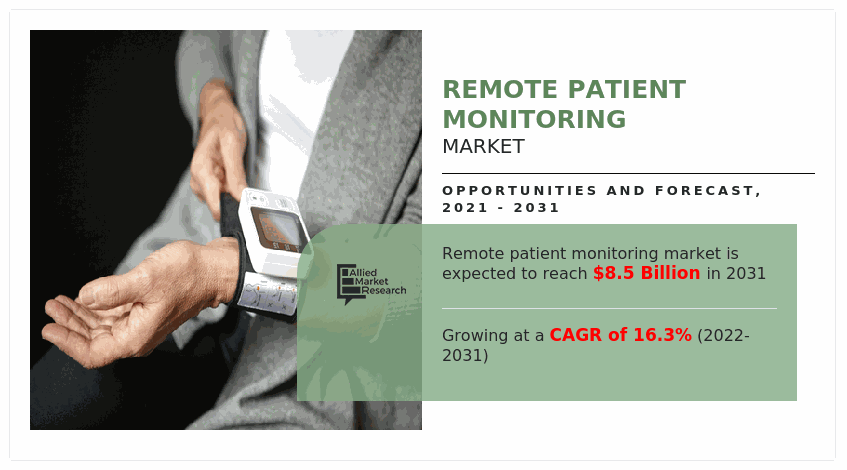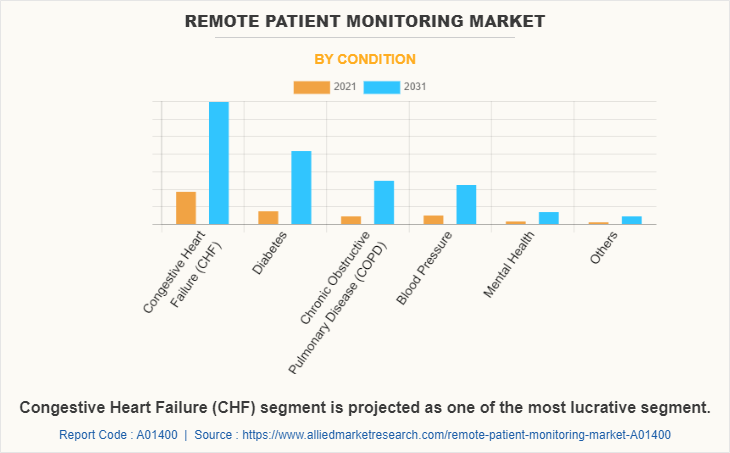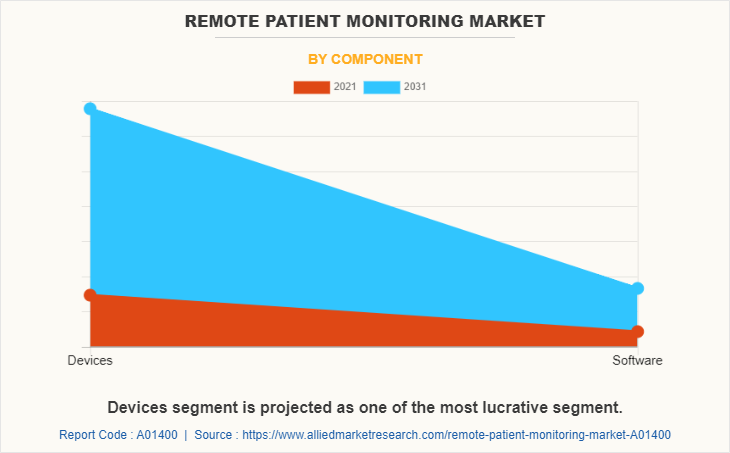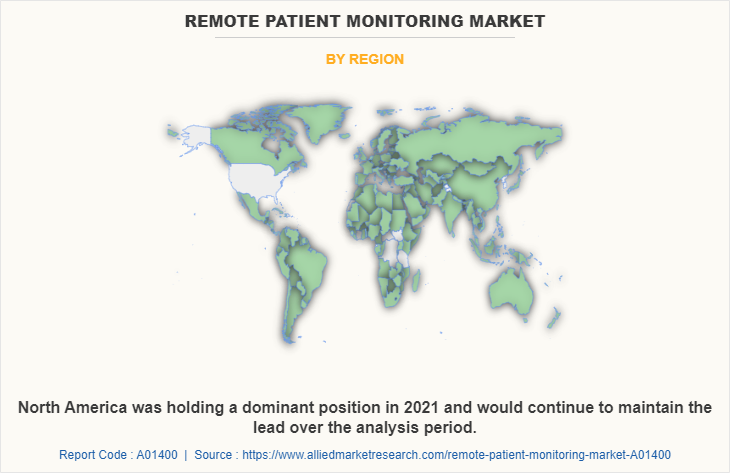Remote Patient Monitoring Market Research, 2031
The global remote patient monitoring market was valued at $1.9 billion in 2021, and is projected to reach $8.5 billion by 2031, growing at a CAGR of 16.3% from 2022 to 2031.
Remote patient monitoring collects medical and other types of health data like clinical data, patient registry and patient current health status is transmitted to a healthcare provider using digital technologies. The information can be gathered at patient's home, saving money on care and hospitalization. Increase in number of geriatric population and rise in disposable income drive the growth of the remote patient monitoring market share. In recent years, there has been an increase in demand to improve healthcare infrastructure, surge in cost benefits of telehealth, and rise in remote patient monitoring technologies, owing to the rapidly growing global population and surge in occurrence of chronic diseases.

The growth of remote patient monitoring market size is driven by increase in the prevalence of lifestyle disorder, increase in usage of remote patient monitoring devices, and an increase in the geriatric population. Remote patient monitoring devices are becoming more popular across the globe since they are simple to use and can be utilized by people of all ages. Furthermore, geriatric population is more prone to chronic disorders, hence, remote patient devices are used by them. According to the World Population Ageing 2020 study, in 2020, there were $703 million individuals aged 65 and above across the globe. In 2050, this population is expected to increase to $1.5 billion. Globally, the proportion of people aged 65 and above surged from 6% in 1990 to 9% in 2019, with a projected growth rate of 16% in 2050. Government rules, reimbursement concerns, lack of awareness, and exorbitant expenses, on the other hand, hinder the market expansion. On the contrary, technological improvements are projected to provide profitable prospects for market players in the future. Remote monitoring systems, mobile cardiac telemetry devices, mobile personal digital assistant (PDA) systems, ambulatory wireless EEG recorders, and ambulatory event monitors are important elements supporting the remote patient monitoring market growth. Furthermore, these gadgets are small and portable, allowing patients to use them every time without any discomfort. In addition, these technologies allow for continuous monitoring of the patient's condition. Rise in demand for home-based monitoring equipment drives the growth of the market during remote patient monitoring market forecast. According to the Center for Medicare and Medicaid Services 2021, every year, remote monitors assist several high-risk patients from the preventing to be  readmitted. to the hospital. Remote monitoring clients report a 76% decrease in readmission rates, an average of 89 % patient satisfaction, and a total medical cost savings of over $370 million.
The World Health Organization (WHO) on January 30, 2021 declared COVID-19 as a pandemic and general wellbeing crisis of international concern. COVID-19 has impacted around 210 countries across the globe ,owing to the COVID-19 pandemic. State-run administrations across the globe declared inescapable lockdowns as well as social distancing measures to forestall breakdown of the healthcare structure. States have additionally given constraints and preventions on undertakings and elective surgeries. These obstructions continue to influence the growth of different industries and the enhanced response toward these regulations affects the industry. The distribution, production, and store network have been impacted, due to lockdowns across the globe.
Similarly, the remote patient monitoring market had a positive impact during the pandemic, owing to social distancing norms and least availability of hospital beds prompted for maximum adaptation of home-based patient care system. Hence, overall, the pandemic had a positive impact on remote monitoring market.
The remote patient monitoring market is segmented into Condition and Component.
The emote patient monitoring market size is segmented on the basis of condition, component, and region. By condition, tit is classified into congestive heart failure, diabetes, chronic obstructive pulmonary disease, blood pressure, mental health and others. By component it is segregated into devices and software.
Region wise, the market is analyzed across North America, Europe, Asia-Pacific, and LAMEA.

Segment Review
By Condition Type
By condition type, the congestive heart failure segment dominated the market in 2021 with a revenue of $916.75 million. Growth of the segment is attributed to rising burden of chronic diseases such as heart diseases due to lifestyle changes and the rising geriatric population.

By Component Type
By component type, the device segment dominated the market in 2021 with a revenue of $1,453.63 million. The growth of the segment can be attributed to surge in incidences of chronic diseases, such as diabetes and COPD and the growing demand for home-based monitoring devices are responsible for the high growth rate.

By Region
Region wise, in remote patient monitoring industry, North America dominated the global market in 2021 with a revenue of $746.40 million. The major factors driving the remote patient monitoring market size growth include the growing burden of chronic diseases, increasing geriatric population, demand for wireless and portable systems, and the presence of a sophisticated reimbursement structure.
Major key players that operate in the global remote patient monitoring market are Abott Laboratories, Biotronik SE Co. KG, Boston Scientific Inc., Datos Health, General Electric, Honey Well International, Johnson & Johnson, Koninklijike Philips N.V., Medtronic, and Nihon Kohden.
Key Benefits For Stakeholders
- This report provides a quantitative analysis of the market segments, current trends, estimations, and dynamics of the remote patient monitoring market analysis from 2021 to 2031 to identify the prevailing remote patient monitoring market opportunity.
- The market research is offered along with information related to key drivers, restraints, and opportunities.
- Porter's five forces analysis highlights the potency of buyers and suppliers to enable stakeholders make profit-oriented business decisions and strengthen their supplier-buyer network.
- In-depth analysis of the remote patient monitoring market segmentation assists to determine the prevailing market opportunities.
- Major countries in each region are mapped according to their revenue contribution to the global market.
- Market player positioning facilitates benchmarking and provides a clear understanding of the present position of the market players.
- The report includes the analysis of the regional as well as global remote patient monitoring market trends, key players, market segments, application areas, and market growth strategies.
Remote Patient Monitoring Market Report Highlights
| Aspects | Details |
| By Condition |
|
| By Component |
|
| By Region |
|
| Key Market Players | Aerotel Medical Systems (1988) Ltd., General Electric Company, Omron Corporation, Medtronic Plc, Biotronik SE & Co. KG, Boston Scientific Corporation, Johnson and Johnson, Masimo Corporation, Nihon Kohden Corporation, Abbott Laboratories |
Analyst Review
Remote patient monitoring collects medical and other types of health data and transmits it to a healthcare provider using digital technologies. These expenses can be greatly lowered by using remote patient monitoring systems, which is projected to drive market expansion. In addition, chronic diseases can be avoided by adopting remote monitoring systems because early warning signs and progress trackers, as well as prompt support, will be supplied to patients, delaying emergency department visits and hospitalizations in the future. The remote patient monitoring system has various advantages, including lower medical costs because the entire hospitalization fee is avoided, which is driving more patients to choose this system over traditional hospitalization.
Factors such as the expanding geriatric population is likely to propel the growth of remote patient monitoring industry . According to the World Health Organization, the proportion of people aged 65 and above surged from 6% in 1990 to 9% in 2019, with a projected growth rate of 16% in 2050. As the number of individuals in the segment grows, so will the demand for remote patient monitoring systems, as the number of patients suffering from chronic diseases grows. Although, many healthcare professionals are opposed to the remote patient monitoring system since patients' reliance on them will decrease, perhaps limiting their professional advancement. Moreover, it also aids in significantly lowering hospitalization, nursing, travel, and other expenses.
In addition, North America accounted for the largest remote patient monitoring market share, which is attributed to surge in cancer, cardiovascular disorders, and demand of home based patient care.
The upcoming trends include burden of chronic diseases, increasing geriatric population, demand for wireless and portable systems, and the presence of a sophisticated reimbursement structure.
North America was the largest regional market for Remote Patient Monitoring Market, owing to growing burden of chronic diseases, increasing geriatric population, demand for wireless and portable systems, and the presence of a sophisticated reimbursement structure.
The leading application of Remote Patient Monitoring Market are congestive heart failure, diabetes, chronic obstructive pulmonary disease, blood pressure and mental health.
Major key players that operate in the global remote patient monitoring market are Abott Laboratories, Biotronik SE Co. KG, Boston Scientific Inc., Datos Health, General Electric, Honey Well International, Johnson & Johnson, Koninklijike Philips N.V., Medtronic, and Nihon Kohden.
The global remote patient monitoring market was valued $1,866.00 million in 2021 and expected to reach $8,451.41 million by 2031, with a CAGR of 16.3% from 2022 to 2031.
Loading Table Of Content...



